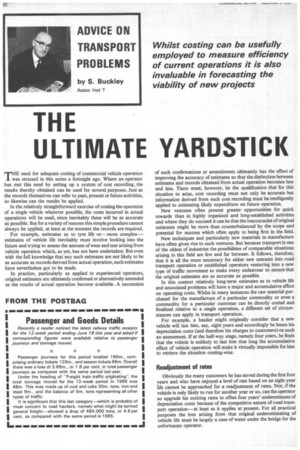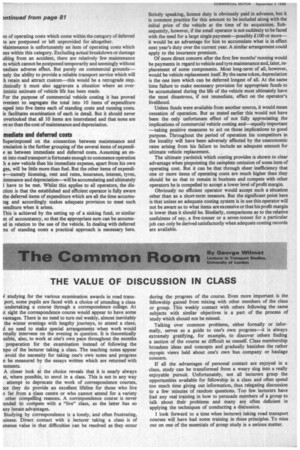THE ULTIMATE YARDSTICK
Page 82

Page 83

Page 84

If you've noticed an error in this article please click here to report it so we can fix it.
Fr HE need for adequate costing of commercial vehicle operation was stressed in this series a fortnight ago. Where an operator has met this need by setting up a system of cost recording, the results thereby obtained can be used for several purposes. Just as the records themselves can refer to past, present or future activities, so likewise can the results be applied.
In the relatively straightforward exercise of costing the operation of a single vehicle wherever possible, the costs incurred in actual operations will be used, since inevitably these will be as accurate as possible. But for a variety of reasons this simple procedure cannot always be applied, at least at the moment the records are required.
For example, estimates as to tyre life or—more complex— estimates of vehicle life inevitably must involve looking into the future and trying to assess the amount of wear and tear arising from vehicle operation which, as yet, has not been undertaken. But even with the full knowledge that any such estimates are not likely to be as accurate as records derived from actual operation, such estimates have nevertheless got to be made.
In practice, particularly as applied to experienced operators, original estimates are ultimately confirmed or alternatively amended as the results of actual operation become available. A succession of such confirmations or amendments ultimately has the effect of improving the accuracy of estimates so that the distinction between estimates and records obtained from actual operation becomes less and less. There must, however, be the qualification that for this situation to arise, cost recording must not only be accurate but information derived from such cost recording must be intelligently applied to estimating likely expenditure on future operation.
New ventures often present greater opportunities for quick rewards than in highly organized and long-established activities and where they do succeed it can be that the inaccuracies of original estimates might be more than counterbalanced by the scope and potential for success which often apply to being first in the field.
New techniques and particularly new materials in manufacture have often given rise to such ventures. But because transport is one of the oldest of industries the possibilities of comparable situations arising in this field are few and far between. It follows, therefore, that it is all the more necessary for either new entrants into road transport operation or established operators venturing into a new type of traffic movement to make every endeavour to ensure that the original estimates are as accurate as possible.
In this context relatively long-term estimates as to vehicle life and associated problems will have a major and accumulative effect on operating costs. Whilst in many instances the raw material purchased for the manufacture of a particular commodity or even a commodity for a particular customer can be directly costed and finalized relative to a single operation, a different set of circumstances can apply in transport operation.
For example, a haulier might originally consider that a new vehicle will last him, say, eight years and accordingly he bases his depreciation costs (and therefore his charges to customers) on such an assessment. If at the half-way stage, namely four years, he finds that the vehicle is unlikely to last him that long the accumulative effect of vehicle operation will make it virtually impossible for him to retrieve the situation costing-wise.
Readjustment of rates Obviously the many customers he has served during the first four years and who have enjoyed a level of rate based on an eight-year life cannot be approached for a readjustment of rates. Nor, if the vehicle is only likely to run for another year or so, can the operator so upgrade his existing rates to offset four years' underestimate of depreciation costs because of the competitive nature of road transport operation—at least as it applies at present. For all practical purposes the loss arising from that original underestimating of vehicle life must be largely a case of water under the bridge for the unfortunate operator. Whilst the subject of replacement of equipment and ultimately premises must enter into all estimates of new commercial and industrial projects, difficulties arising from misjudgment appear to have more unfortunate results in road transport than in some other industries. As with many other industrial problems this situation often arises from a combination of reasons. First there is the fact that road transport industry is made up of a large number of small units. With an average size of fleet of around four vehicles it is unlikely that such fleet operators will have the expertise, initially at least, to make the necessary estimates as to the cost of future operation adequately.
Sizeable outlay
This is in contrast to entry into other types of industry which involves a sizeable outlay from the start in premises and equipment and correspondingly the number of personnel employed. This need, of course, arises from the economies of scale associated with either partial mass production or specialization. Such a venture in turn would necessitate considerable financial outlay. In the process of negotiating the necessary credit facilities the bank or financial house concerned will obviously, in its own interest, require detailed and authoritative costings as to the proposed venture.
Whilst it is arguable that this requirement, at least to some extent, should apply in the setting up of a transport organization it does not apply in anything like the same degree when an owner-driver is buying his first vehicle, whether new or second-hand. Moreover, whilst the unfortunate experience of a new entrant failing to stay the course in the road transport industry might seem unlikely, on a national scale, to have any significant influence on a total goods vehicle fleet of over 1.6m., the overall effect is, in fact, substantial. This is because over 90 per cent of all goods vehicle operators have five vehicles or less and even with this small number of vehicles per operator they constitute 39 per cent of the total goods vehicles operating in this country. Additionally, as established operators know only too well, it is a long-standing problem of the industry that even if the uneconomic operator eventually goes to the financially, damage in the meantime has been done to the indu generally and particularly in the area in which he operates. NI over, successive owner-drivers seem only too ready to try t luck after others have failed.
A solution to this problem is undoubtedly an adequate knowle of the costing of commercial operation and this in turn requ technical knowledge on which to make a realistic assessment only of vehicle life, but also as to the extent and cost of maintenance which will be necessary during the time the veh is in the operator's possession.
Patently unrealistic
Reverting now to the situation where an operator may h over-estimated the life of a vehicle, a further difficulty can aris for example, an original estimate of eight years is shown tc patently unrealistic at the half-way stage. The unfortunate open will have already conditioned his customers to a level of rate ba on a below-average cost of depreciation. Technically it might jus possible to retrieve this situation by increasing the amount of tn. tenance and likewise its cost so as to achieve the original eight-) plan.
But it is at such a juncture that some small operators do just reverse. To retrieve what is basically an uneconomic situation as of operating costs which come within the category of deferred ts are postponed or left unprovided for altogether.
Vlaintenance is unfortunately an item of operating costs which nes within this category. Excluding actual breakdown or damage tilting from an accident, there are relatively few maintenance ts which cannot be postponed temporarily and seemingly without nediate adverse effect. But purely on commercial groundsnely the ability to provide a reliable transport service which will h retain and attract custom—this would be a retrograde step. :thnically it must also aggravate a situation where an overimistic estimate of vehicle life has been made.
For the purpose of commercial vehicle costing it has proved wenient to segregate the total into 10 items of expenditure luped into five items each of standing costs and running costs. is facilitates examination of each in detail. But it should never overlooked that all 10 items are interrelated and that none are ■ re so than the cost of maintenance and depreciation.
mediate and deferred costs Superimposed on the connection between maintenance and reciation is the further grouping of the several items of expendi e as between immediate and deferred costs. Assuming an ennt into road transport is fortunate enough to commence operation h a new vehicle then his immediate expense, apart from his own ges, will be little more than fuel. But the other items of expendie—namely licensing, rent and rates, insurance, interest, tyres, intenance and depreciation—will be accumulating and ultimately I have to be met. Whilst this applies to all operators, the disction is that the established and efficient operator is fully aware the deferred items of expenditure which are all the time accumuing and accordingly makes adequate provision to meet such )enditure when it arises.
This is achieved by the setting up of a sinking fund, or similar m of accountancy, so that the appropriate sum can be accumuxl in relation to the use of the vehicle. In dealing with deferred ns of standing costs a practical approach is necessary here. Strictly speaking, licence duty is obviously paid in advance, but it is common practice for this amount to be included along with the initial price of the vehicle at the time of its acquisition. Subsequently, however, if the small operator is not suddenly to be faced with the need for a large single payment—possibly £100 or more— it would be an advantage for him to accumulate what is in effect next year's duty over the current year. A similar arrangement could apply to the insurance premium.
Of more direct concern after the first few months' running would be payments in regard to vehicle and tyre maintenance and, later, replacement of some components. Most long-term of all, however, would be vehicle replacement itself. By the same token, depreciation is the one item which can be deferred longest of all. At the same time failure to make necessary provision for appropriate funds to be accumulated during the life of the vehicle must ultimately have the most disastrous, if not immediate, effect on the operator's livelihood.
Unless funds were available from another source, it would mean cessation of operation. But as stated earlier this would not have been the only unfortunate effect of not fully appreciating the implications of commercial vehicle costing and—equally important —taking positive measures to act on those implications to good purpose. Throughout the period of operation his competitors in the locality will have been adversely affected by the uneconomic rates arising from his failure to include an adequate amount for ultimate vehicle replacement.
The ultimate yardstick which costing provides is shown to clear advantage when pinpointing the complete omission of some item of operating cost. But it can be that through sheer inefficiency that one or more items of operating costs are much higher than they should be so that to remain in business and compete with other operators he is compelled to accept a lower level of profit margin.
Obviously no efficient operator would accept such a situation other than as a short-term measure. But the significant point here is that unless an adequate costing system is in use this operator will not be aware as to what items are excessive or that his profit margin is lower than it should be. Similarly, comparisons as to the relative usefulness of say, a five-tonner or a seven-tonner for a particular job can only be derived satisfactorily when adequate costing records are available.
































































































































